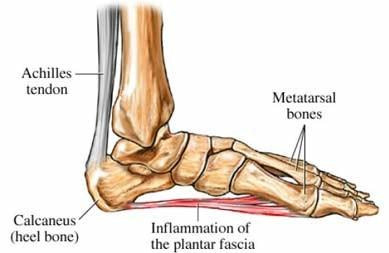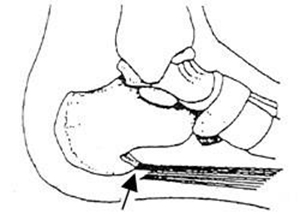 The heel absorbs the shock of your foot striking the ground as it is put down and starts springing you forward on the next step. The heel is attached to the front of the foot by a number of strong ligaments which run between the front part of the calcaneum and various other parts of the foot. The strongest ligament is the plantar fascia, which attaches the heel to the toes and helps to balance the various parts of the foot as you walk. It therefore takes a lot of stress as you walk.
The heel absorbs the shock of your foot striking the ground as it is put down and starts springing you forward on the next step. The heel is attached to the front of the foot by a number of strong ligaments which run between the front part of the calcaneum and various other parts of the foot. The strongest ligament is the plantar fascia, which attaches the heel to the toes and helps to balance the various parts of the foot as you walk. It therefore takes a lot of stress as you walk.
In some people the plantar fascia becomes painful and worn. This usually happens where it is attached to the heel bone, although sometimes it happens in the mid-part of the foot. This condition is called plantar fasciitis. Usually plantar fasciitis eventually gets better itself, but this can take months or even years. If you have it once you are more likely to get it again.
At the site of the worn plantar fascia attachment some extra bone may form, producing a small “spur”. These heel spurs are commoner in people with plantar fascitis, but they can be found in people with no heel pain. The heel spur is caused by the same process as the heel pain, but the spur is not itself the cause of the pain.
Only if all non-surgical treatments fail would an operation be considered.
 THE SURGERY
THE SURGERY
A cut is made about 3cm long on the inner side of your heel. The aim of an operation is to release part of the plantar fascia from the heel bone and reduce the tension in it.
At the same time the small nerves on the inner side of your heel are found and released as these are sometimes trapped by bands of tight tissue.
The cut is sutured and dressings are applied and a plaster is applied.
CAN IT BE DONE AS A DAY CASE OPERATION ?If you are otherwise fit, and there is someone who can collect you afterwards and stay with you overnight, the operation can be done as a day case. If you have other medical problems, or have no-one at home with you, you will have to stay overnight, and you may have to come into hospital the day before for medical tests or treatment. Almost always this surgery is done as a day case operation. WILL I HAVE TO GO TO SLEEP (GENERAL ANAESTHETIC)?The operation is usually done under general anaesthetic (asleep). Alternatively, an injection in the back or leg can be done to make the foot numb while the patient remains awake. The anaesthetist will advise you about the best choice of anaesthetic for you. In addition, local anaesthetic may be injected into your leg or foot while you are asleep to reduce the pain after the operation even if you go to sleep for the surgery. You will also be given pain-killing tablets as required. WILL I HAVE A PLASTER CAST ON AFTERWARDS ?A plaster is applied primarily to assist in wound healing. This remains for the first two weeks. |
FOLLOWING YOUR SURGERY
-
On the Ward
There will be a half plaster round your ankle. When you have recovered from your anaesthetic, you can get up with the help of the physiotherapist who will teach you how to use crutches. It is important to avoid putting weight through your foot for the first two weeks. When you are safe and comfortable, you will be discharged from hospital.
-
When you go home
It is very important that the leg remains elevated most of the time in the first 2 weeks. Do not wet or remove the dressings.
It is normal to expect:
-
SWELLING – This can be minimised by elevating your foot above your heart.
-
PAIN – You will receive a prescription for pain medication on discharge from hospital. Pain can also be minimised by elevating your leg.
-
BLEEDING – This always occurs. You may notice some oozing through the bandages.
Further AppointmentsYou will be seen again 10-14 days after your operation. Your foot and ankle will be examined and the findings of your surgery will be discussed with you. The plaster will be removed and stitches removed. Physiotherapy is often prescribed at this stage, but many people do not need it and can exercise on their own. A further check-up will usually be arranged to check your progress. The stitches are usually made of dissolving material and dissolve after 3-4 weeks without needing to be removed. If you have trouble with them, contact us. |
HOW SOON CAN I….
-
WALK ON THE FOOT?
You should not put weight through our foot for 10-14 days. You can walk on the ankle after the critical first two weeks when wound healing is important.
-
GO BACK TO WORK?
If you are comfortable and your work is not too demanding, you could go back to work within a week. However, if you have a heavy manual job you may not be able to go back for a month or more.
-
DRIVE?
If you have an automatic car and have an operation on your left ankle, you could drive within a couple of days of the operation. Otherwise you can drive about 4-6 weeks after surgery, depending mainly on your comfort.
-
PLAY SPORT?
As you recover from your operation, you can gradually increase your activity, determined by comfort and the amount of swelling and flexibility in the ankle. Start with walking and cycling, then light running. Make sure your foot and ankle are fairly flexible before moving to twisting or impact activities, and make sure you can turn and jump comfortably before returning to contact sports.
Most people who have an operation are better afterwards, but it can take months to get the benefit of the operation and the wound can take a while to heal fully. Tingling or numbness on the side of the heel may occur after operation. Full recovery can take four to six months.
IF YOU ARE CONCERNED:
|
